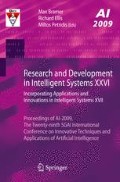Abstract
The paper considers the problem of selecting individuals in the current population in genetic algorithms for crossover to find a solution with high fitness for a given optimization problem. Many different schemes have been described in the literature as possible strategies for this task but so far comparisons have been predominantly empirical. It is shown that if one wishes to maximize any linear function of the final state probabilities, e.g. the fitness of the best individual in the final population of the algorithm, then a best probability distribution for selecting an individual in each generation is a rectangular distribution over the individuals sorted in descending sequence by their fitness values. This means uniform probabilities have to be assigned to a group of the best individuals of the population but probabilities equal to zero to individuals with lower fitness, assuming that the probability distribution to choose individuals from the current population can be chosen independently for each iteration and each individual. This result is then generalized also to typical practically applied performance measures, such as maximizing the expected fitness value of the best individual seen in any generation.
Access this chapter
Tax calculation will be finalised at checkout
Purchases are for personal use only
Preview
Unable to display preview. Download preview PDF.
References
S. Boettcher and A. G. Percus. Extremal Optimization: Methods derived from Co-Evolution. In GECCO-99, Proceedings of the Genetic and Evolutionary Computation Conference, pages 825–832, Orlando, Florida, July 1999.
P. G. Busacca, M. Marseguerra, and E. Zio. Multiobjective Optimization by Genetic Algorithms: Application to Safety Systems. Reliability Engineering & System Safety, 72(1):59–74, April 2001.
M. Chakraborty and U. K. Chakraborty. An Analysis of Linear Ranking and Binary Tournament Selection in Genetic Algorithms. In Proceedings of the International Conference on Information, Communications and Signal Processing, pages 407–411, Singapore, September 1997.
U. K. Chakraborty, K. Deb, and M. Chakraborty. Analysis of Selection Algorithms: A Markov Chain Approach. Evolutionary Computation, 4(2):133–167, 1997.
G. Dueck and T. Scheuer. Threshold Accepting: A General Purpose Optimization Algorithm Appearing Superior to Simulated Annealing. Journal of Computational Physics, 90:161–175, 1990.
A. Franz and K. H. Hoffmann. Optimal Annealing Schedules for a Modified Tsallis Statistics. Jounal of Computational Physics, 176(1):196–204, February 2002.
A. Franz and K. H. Hoffmann. Threshold Accepting as Limit Case for a Modified Tsallis Statistics. Applied Mathematics Letters, 16(1):27–31, January 2003.
A. Franz, K. H. Hoffmann, and P. Salamon. Best Possible Strategy for Finding Ground States. Physical Review Letters, 86(23):5219–5222, June 2001.
T. Friedrich, P. S. Oliveto, D. Sudholt, and C. Witt. Theoretical Analysis of Diversity Mechanisms for Global Exploration. In Interational Genetic and Evolutionary Computation Conference 2008, pages 945–952, Atlanta, Georgia, July 2008. ACM Press.
E. Happ, D. Johannsen, C. Klein, and F. Neumann. Rigorous Analyses of Fitness-Proportional Selection for Optimizing Linear Functions. In Interational Genetic and Evolutionary Computation Conference 2008, pages 953–960, Atlanta, Georgia, July 2008. ACM Press.
K. H. Hoffmann, F. Heilmann, and P. Salamon. Fitness Threshold Accepting over Extremal Optimization Ranks. Physical Review E, 70(4):046704, October 2004.
S. Kikuchi, D. Tominaga, M. Arita, K. Takahashi, and M. Tomita. Dynamic Modeling of Genetic Networks Using Genetic Algorithm and S-System. Bioinformatics, 19(5):643–650, 2003.
S. Kirkpatrick, C. Galatt, and M. Vecchi. Optimization by simulated annealing. Science, 4598:671–680, 1983.
A. Kolen. A Genetic Algorithm for the Partial Binary Constraint Satisfaction Problem: an Application to a Frequency Assignment Problem. Statistica Neerlandica, 61(1):4–15, February 2007.
J. Lässig, K. H. Hoffmann, and M. Enăachescu. Threshold Selecting: Best Possible Probability Distribution for Crossover Selection in Genetic Algorithms. In Interational Genetic and Evolutionary Computation Conference 2008, pages 2181–2185, Atlanta, Georgia, July 2008. ACM Press.
A. Moraglio and R. Poli. Inbreeding Properties of Geometric Crossover and Non-geometric Recombinations. In C. R. Stephens, M. Toussaint, D. Whitley, and P. F. Stadler, editors, Foundations of Genetic Algorithms: 9th International Workshop, pages 1–14, Mexico City, Mexico, June 2007. Springer Berlin.
H. Mühlenbein and D. Schlierkamp-Voosen. Predictive Models for the Breeder Genetic Algorithm. Evolutionary Computation, 1(1):25–49, 1993.
D. Srinivasan and L. Rachmawati. An Efficient Multi-objective Evolutionary Algorithm with Steady-State Replacement Model. In Proceedings of the 8th annual conference on Genetic and evolutionary computation, pages 715–722, Seattle, Washington, USA, July 2006.
Author information
Authors and Affiliations
Corresponding author
Editor information
Editors and Affiliations
Rights and permissions
Copyright information
© 2010 Springer-Verlag London
About this paper
Cite this paper
Lässig, J., Hoffmann, K.H. (2010). On the Structure of a Best Possible Crossover Selection Strategy in Genetic Algorithms. In: Bramer, M., Ellis, R., Petridis, M. (eds) Research and Development in Intelligent Systems XXVI. Springer, London. https://doi.org/10.1007/978-1-84882-983-1_19
Download citation
DOI: https://doi.org/10.1007/978-1-84882-983-1_19
Published:
Publisher Name: Springer, London
Print ISBN: 978-1-84882-982-4
Online ISBN: 978-1-84882-983-1
eBook Packages: Computer ScienceComputer Science (R0)

